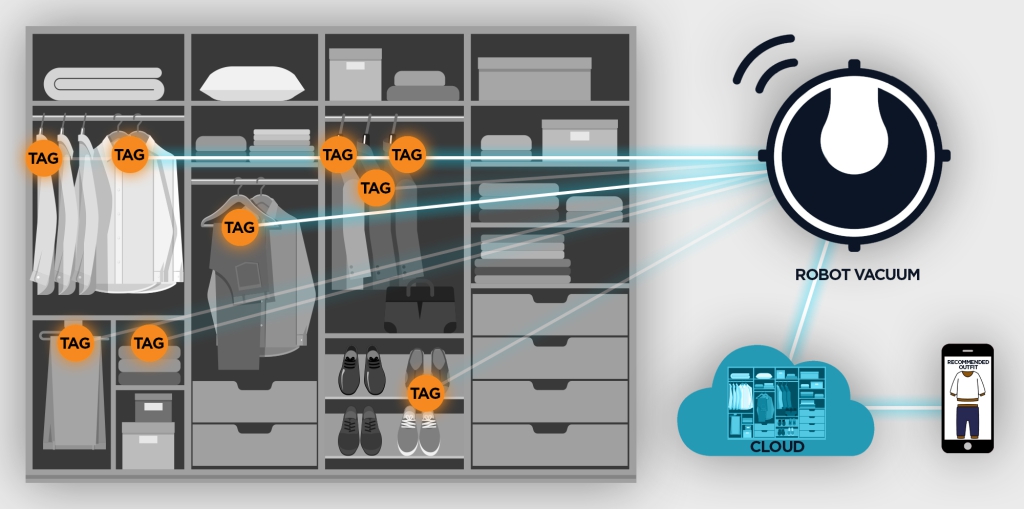Tiffany Lee, May 30, 2023
Guo aims to develop smart tech for household objects
When you’re out and about, smart devices can tell you a lot about what’s happening inside your home — networked thermostats convey the temperature, smart doorbells provide a view of your front porch and internet-connected garage doors apprise you of comings and goings.
But a truly “smart home” — one that can help occupants locate a missing sweater or determine from afar if they’re short on eggs or milk — is still on the horizon. University of Nebraska–Lincoln engineer Hongzhi Guo is using National Science Foundation funding to develop a wireless communications technology that could provide a digital twin of a home, including detailed information about the location and status of everyday items like clothes, books and sundries lining pantry shelves.
“The Internet of Things is a pretty mature technology in that we can connect sensors,” said Guo, assistant professor of computing. “But still, there is a big gap. A lot of items do not have a digital ID. We don’t know their status. If we want to build a virtual model for our life, then we need a technology to connect it with everything in the physical world. This technology would fill that gap.”
Guo, who joined the university in January, transferred a nearly $500,000 award from NSF’s Faculty Early Career Development Program to Nebraska from his former institution, Norfolk State University. He is in the first year of the project, which aims to expand the range and function of near-field communication, known as NFC. It’s the short-range wireless technology that enables contactless pay, card-access building entry and e-ticketing. Guo envisions an expanded range of NFC applications, including digital twinning, a smart postage stamp system and an enhanced “Internet of Clothing,” where wearable tags embedded in clothes transmit information.
To achieve it, he is building new hardware for NFC-linked devices and developing the algorithms and software that will enable long-range, uninterrupted, secure communication in ultra-dense environments, like a closet crowded with clothes or a mail truck packed with envelopes. Rather than manually scanning each tagged item, which is the current practice, Guo envisions an autonomous robot capable of scanning NFC tags.
The system’s success hinges on extending the range of NFC technology. Today’s NFC systems operate at a range of 5 centimeters or fewer. Guo aims to extend that range to about 1 meter, or about 3 and a quarter feet. This longer range means that a roving robot — such as a robot vacuum in a domestic setting, for example — could collect tag data from farther away. This would be more practical in ultra-dense environments, where there could be as many as 1,000 tags in a square meter range.
To enable this, Guo will pursue advances in both hardware and software. Near-field communication is achieved through magnetic field induction between two devices: When a device’s antenna — a tightly coiled piece of wire — is brought in close range with the other device’s antenna, they “couple,” creating a current that facilitates contactless communication.
To achieve longer-range capability, Guo is building antennae that are larger, of a higher quality factor and positioned in a tri-axis configuration, which improves alignment between the robot and the tag. He’s also developing anti-collision software, which will ensure that the signals coming from the tightly packed NFC tags don’t interfere with each other, as well as orientation and sensing algorithms that support detailed messages about an item. A tagged water bottle, for example, could convey information about where in the house it’s located, how much water it contains and whether it’s standing upright or tipped on its side.
On the tag side of things, Guo’s group will use analytical models to select off-the-shelf tags. Modern NFC tags are inexpensive, printable on paper and clothes, and often washable and flexible.

Guo is also contending with the enhanced security risks of long-range communication systems, which are inherently more vulnerable. He’s developing security strategies called power-efficient jamming algorithms to block malicious interference from unauthorized tag readers.
Though Guo has been working on near-field communication technology since he was a graduate student, the CAREER project marks a new trajectory for him. Much of his work to this point has focused on making NFC operable in hostile environments, like underwater or underground.
“But NFC technology has the potential to find more applications in our daily life,” Guo said. “I wanted to improve the impact of my research. I wanted to explore what would happen if we used NFC for the metaverse and for digital twinning: What can we do in these areas?”
To integrate education into his research program — a key component of CAREER projects — Guo is incorporating inquiry-based learning into his classrooms. This approach weaves questions and real-world applications into the material, which helps students engage in learning and understand the purpose behind the course content.
The National Science Foundation’s CAREER award supports pre-tenure faculty who exemplify the role of teacher-scholars through outstanding research, excellent education and the integration of education and research.





